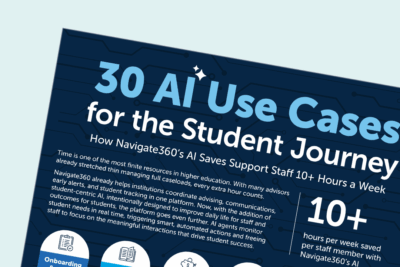The right and wrong ways to hold departments accountable for student success
Academic leaders need the support of departments and their faculty to improve institutional graduation rates. But if you measure departments on the time from their majors’ matriculation to graduation, you have probably heard at least one of these common objections:
- Departments may not even have contact with their majors until they have completed first- and second-year prerequisites and general education requirements
- Most students change their major before they graduate, and departments can’t control students’ experiences in their previous majors
- Transfer students from other institutions face barriers to graduation based on what happened at their prior institution, not just in the current department
This resource is part of the Design Effective Academic Department Reviews Roadmap. Access the Roadmap for stepwise guidance with additional tools and research.
100+

During our 2017-2018 research study, Academic Vital Signs, we interviewed over 100 departmental, college, and university leaders to identify how institutions evaluate academic departments on several institutional priorities, including student success. Unfortunately, many of these efforts stall when department leaders and faculty balk at unfair, inaccurate metrics. To overcome this faculty resistance and pinpoint the departmental role, academic leaders need to pick fair, department-aligned metrics that prompt clear next steps.
Instead of tracking departments’ overall graduation rates, a better approach is to measure the junior graduation rate, or the two- and four-year graduation rates and time to degree of students in the major who already have 60 credits.
At 60 credits, or junior year, most students are focused on taking courses within the major, where departmental policy and planning affect their experiences directly and immediately. The junior graduation rate allows departments to focus on what they can control, and avoids creating unrealistic expectations around the department’s role in shaping students’ first two years.
What a low junior graduation rate might signify about a department’s needs
At the University of Maine, the provost asked departments to develop individual strategies based on their students’ time to graduation after junior year. Their solutions to improve their junior graduation rates included some of the below:
“Having a great idea or being a charismatic visionary leader is ‘time telling’; building a company that can prosper far beyond the tenure of any single leader and through multiple product life cycles is ‘clock building.’”
Jim Collins
Built to Last: Successful Habits of Visionary Companies
- Redesigning a required course with a low pass rate to facilitate student learning
- Offering more frequent sessions of common required courses
- Aligning requirements with related majors to make it easier for students to switch into the major from outside the department
- Adapting the curriculum so that transfer students can bring in more external credit
Help your departments move from analysis to action
To determine which of these strategies is the best fit, departmental leaders and faculty will need to analyze student progress beyond the junior graduation rate. EAB’s root-cause diagnostic tools help departments move more quickly from analysis to action by highlighting some of the most common reasons behind low junior graduation rates, and tried-and-true strategies from our research to support on-time graduation.
More resources on academic advising
Develop a Student-Centered Academic Advising Model
Learn how advisors can use population health management and coordinated care to prioritize their time toward students with rising risk instead of only focusing on those with urgent, critical needs.
Design Effective Academic Department Reviews
Academic leaders need to create a mission-aligned approach to assess each department’s contributions to institutional strategy through departmental reviews.
More Resources

5 Insights About Changing Student Preferences

Outpacing the New Federal Earnings Mandate
